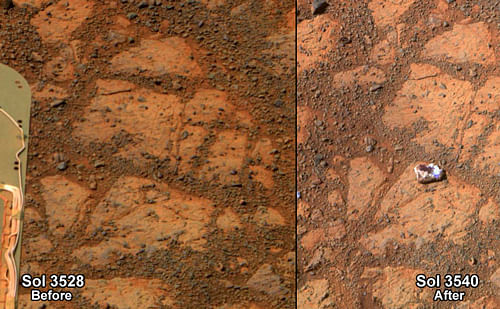
The mysterious Martian rock resembling a jelly doughnut, which appeared in front of NASA's Opportunity rover in early January, is a piece of a larger rock broken and moved by one of the rover's wheels, the US space agency said Friday.
Only about 4 cm, the white-rimmed, red-centered rock dubbed Pinnacle Island caused a stir last month when it appeared in an image the rover took Jan 8 at a location where it was not present four days earlier, Xinhua reported.
Now researchers with NASA's Jet Propulsion Laboratory claimed that the rock mystery has finally been solved, as the rover has sent back more images that show where the rock came from.
"Once we moved Opportunity a short distance, after inspecting Pinnacle Island, we could see directly uphill an overturned rock that has the same unusual appearance," Opportunity Deputy Principal Investigator Ray Arvidson of Washington University in St. Louis said in a statement. "We drove over it. We can see the track. That's where Pinnacle Island came from."
Examination of Pinnacle Island revealed high levels of elements such as manganese and sulfur, suggesting these water-soluble ingredients were concentrated in the rock by the action of water.
"This may have happened just beneath the surface relatively recently," Arvidson said. "Or it may have happened deeper below ground longer ago and then, by serendipity, erosion stripped away material above it and made it accessible to our wheels."
Opportunity landed on Mars January 24, 2004 on what was to be a three-month mission, but instead the rover has lived beyond its prime mission and roved the planet for more than 10 years.
Deccan Herald is on WhatsApp Channels| Join now for Breaking News & Editor's Picks